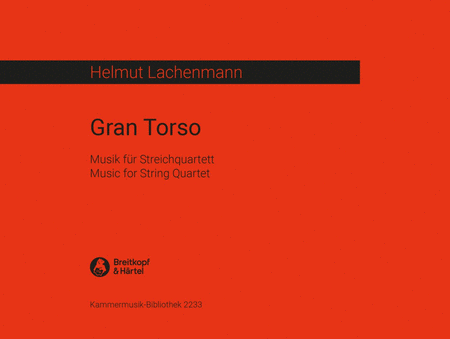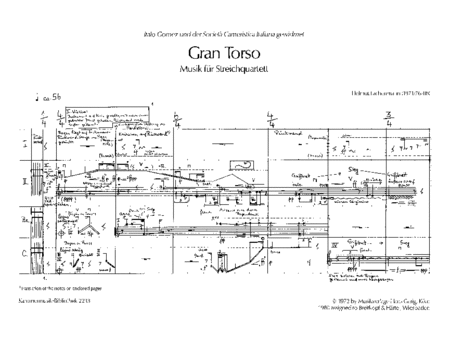Gran Torso
Music for String Quartet
-
Ships in 3 to 4 weeks
Details
Description
SKU: BR.KM-2233
Music for String Quartet. Composed by Helmut Lachenmann. Chamber music; stapled. Kammermusik-Bibliothek (Chamber Music Library). World premiere: Bremen (pro musica nova), May 6, 1972Have a look into KM 2261. Music post-1945; New music (post-2000). Full score. Composed 1971/78/88. 24 pages. Duration 23'. Breitkopf and Haertel #KM 2233. Published by Breitkopf and Haertel (BR.KM-2233).ISBN 9790004501375. 10.5 x 14 inches.
Gran Torso, for string quartet, was composed in 1971 and revised in 1978. It belongs to a series of works, including Air, Kontrakadenz, Pression and Klangschatten, whose concept of material attempts to free itself from convention. That is, instead of using the sound itself as a point of departure, structural and formal hierarchies are derived from the mechanical and physical conditions present during the process of sound production. It is clear that such a radical break with tradition is not easily achieved: the instrument, the given means, the resonating body itself (as the embodiment of convention) all work against such attempts (with the extended performance techniques representing only the tip of the iceberg of deep-seated contradictions where the bourgeois artist is concerned). Implicit in such a challenge, however, is a claim to aesthetic pregnance: an offer, if one would have it, of uncomprosing beauty.(Helmut Lachenmann, 1978)CDs/LPs:Berner StreichquartettCD col legno 0647 277Berner StreichquartettLP col legno 5504Societa Cameristica ItalianaLP ABT ERZ 1003Arditti String QuartetCD KAIROS, 0012662KAIstadler quartettCD NEOS 10806The JACK QuartetCD mode 267Stadler Quartett, Rg. Caroline SiegersDVD NEOS 51001Bibliography:Alberman, David: Abnormal Playing Techniques in the String Quartets of Helmut Lachenmann, in: Helmut Lachenmann Music with matches, hrsg. von Dan Albertson, Contemporary Music Review 24 (2005), Vol. 1, pp. 39-51.Dulaney, Maxwell: Continuing the Tradition Untraditionally: Helmut Lachenmann's Restructuring of Musical Dialectic through an Analysis of his Three String Quartets, and an Original Composition, Harmonic Concerto, Diss. Brandeis University, MI 2013.Egger, Elisabeth: Kontinuitat, Verdichtung, Synchronizitat. Zu den grossformalen Funktionen des gepressten Bogenstrichs in Helmut Lachenmanns Streichquartetten, in: Musik als Wahrnehmungskunst. Untersuchungen zu Kompositionsmethodik und Horasthetik bei Helmut Lachenmann, hrsg. von Christian Utz und Clemens Gadenstatter (= musik.theorien der gegenwart 2), Saarbrucken: Pfau 2008, pp. 155-171.Hermann, Matthias: Helmut Lachenmann - Gran Torso, in: Analyse Musik XX. Jahrhundert (2). Postserielle Konzepte Klangflachen Aleatorik (= Materialien zur Musiktheorie 4), Saarbrucken: Pfau 2002, pp. 134-152.Hiekel, Jorn Peter: Die Streichquartett Gran Torso und Grido von Helmut Lachenmann, in: Lucerne Festival, Sommer 2005 Neuland, Konzertprogramm 6, pp. 65-69.Houben, Eva-Maria: Helmut Lachenmann: Gran Torso ..., in: dies., Musikalische Praxis als Lebensform (= Musik und Klangkultur 27), Bielefeld: Transcript 2018, S. 208-212Lehmann, Harry: Erhabenheit - Ereignis - Ambivalenz. Zur Asthetik der Neuen Musik, in: Neue Zeitschrift fur Musik 176 (2015), Heft 5, pp. 22-27.Mosch, Ulrich: Kunst als Medium der Ungeborgenheit. Streichquartette und soziale Funktion des Komponierens bei Helmut Lachenmann, in: Positionen 81 (November 2009), pp. 37-39.ders.: Was heisst Interpretation bei Helmut Lachenmanns Streichquartett ,,Gran Torso"?, in: Wessen Klange? Uber Autorschaft in neue Musik, hrsg. Von Hermann Danuser und Matthias Kassel (= Veroffentlichungen der Paul Sacher Stiftung 12), Mainz u.a.: Schott 2017, S. 163-186Nonnenmann, Rainer: Werke als Schlussel zu Werken? Zur umstrittenen Kategorie ,,Schlusselwerke der neuen Musik", in: MusikTexte, Heft 147 (November 2015), pp. 35-46.Stork, Astrid: Materialbegriff und Strukturdenken. Untersuchungen zu den Streichquartetten von Helmut Lachenmann, Magisterarbeit Ruhr-Universitat Bochum 1992Tsao, Ming: Helmut Lachenmann's "Sound Types", in: Perspectives of New Music 52 (2014), Heft 1, pp. 217-238.Velazquez, Rossana Lara: Composicion y escucha burguesa: Principios de continuidad y ruptura en el cuarteto Gran Torso de Helmut Lachenmann, Diss. Universidad Nacional Autonoma de Mexico 2011.Zenck, Martin: Die mehrfache Codierung der Figur: Ihr defigurativer und torsohafter Modus bei Johann Sebastian Bach, Helmut Lachenmann und Auguste Rodin, in: de figura. Rhetorik Bewegung Gestalt, Text und Bild, hrsg. von Gabriele Brandstetter und Sibylle Peters, Munchen 2003, pp. 265-288.
World premiere: Bremen (pro musica nova), May 6, 1972.


 Share
Share